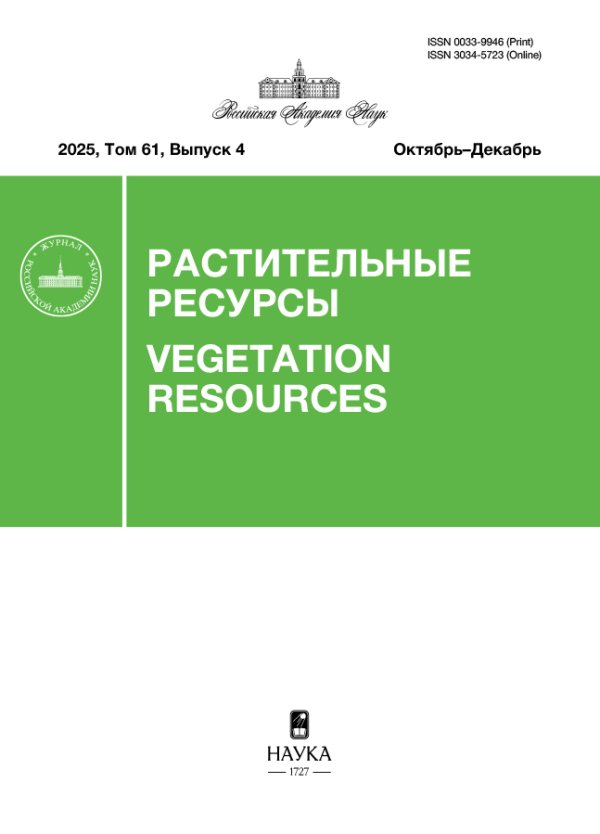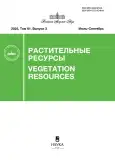Effect of Long-Term Soil Application of Major Nutrients on Pinus sylvestris (Pinaceae) Wood Microstructure
- Authors: Neronova Y.A1
-
Affiliations:
- Forest Institute — a separate subdivision of the Karelian Research Centre of the Russian Academy of Sciences
- Issue: Vol 61, No 3 (2025)
- Pages: 60-73
- Section: Biology of Resource Species
- URL: https://journal-vniispk.ru/0033-9946/article/view/348580
- DOI: https://doi.org/10.7868/S3034572325030044
- EDN: https://elibrary.ru/yfpyko
- ID: 348580
Cite item
Abstract
This paper investigates the effect of long-term annual fertilization with major mineral nutrients (N, K, P) on microstructural parameters of wood in artificial pine stands on fire-affected sandy soils. Fertilization has resulted in augmentation of the annual layer and, hence, a decrease in latewood percentage and density, but the differences in these parameters were below the confidence level. All qualitative characteristics showed the highest values under treatment with nitrogen. Within the observation period, the width of annual rings increased, while the wood density remained as in the control. Under N treatment, the thin-walled early- and latewood tracheids were formed, and their total number in radial rows was the smallest; it was counter-balanced by the formation of a greater number of rows of thick-walled larger-size latewood tracheids in the aftereffect period. Evaluating the set of the parameters in question it was found that wood quality does not deteriorate under nitrogen fertilization. Phosphorus had a minor effect on the wood quality. While the share of latewood and density decreased slightly during the period of observations, annual ring width increased. The greater increment was due to rows of thicker-walled larger-diameter latewood tracheids. Tracheids in earlywood have thinner walls. Fertilization with potassium resulted in a reliable decline in basic density due to lower latewood content compared to the control plot, and to the formation of thin-walled earlywood tracheids. Pine trees on burnt heather cutovers regenerating in lingonberry pine communities consume high amounts of nitrogen. Pine wood from the sites annually fertilized with major nutrients on a long-term basis can be recommended as high-quality sawtimber fulfilling the state standard (GOST 968-68) and the criteria of the Institute of Pulp and Paper Industry Raw Material Laboratory.
About the authors
Ya. A Neronova
Forest Institute — a separate subdivision of the Karelian Research Centre of the Russian Academy of Sciences
Author for correspondence.
Email: neronovaya@krc.karelia.ru
Petrozavodsk, Russia
References
- Soldatova D. N., Ilintsev А. S. 2020. Growth and productivity of pine forest crops named after S. V. Alekseev in the Europian North of Russia. — Lesnoy Zhurnal (Russian Forestry Journal). 1: 99—112. https://doi.org/10.37482/0536-1036-2020-1-99-112 (In Russian)
- Tyukavina O. N., Klevtsov D. N., Drozdov I. I., Melekhov V. I. 2017. Wood density of Scots pine in different growth conditions. — Lesnoy Zhurnal (Russian Forestry Journal). 6: 56—64. https://doi.org/10.17238/issn0536-1036.2017.6.56 (In Russian)
- Havimo M., Rikala J., Sirviö J., Sipi M. 2009. Tracheid cross-sectional dimensions in Scots pine (Pinus sylvestris) — distributions and comparison with Norway spruce (Picea abies). — Silva Fenn. 43(4): 681‒688. https://doi.org/10.14214/sf.188
- Kilyusheva N. V., Feklistov P. A., Ezhova N. V., Bolotov I. N., Filippov B. Yu. 2017. Comparative analysis of mineral content in pine and spruce wood. — Lesnoy Zhurnal (Russian Forestry Journal). 5: 64—72. https://doi.org/10.17238/issn0536-1036.2017.5.64 (In Russian)
- Minin N. S. 2005. [The methods and techniques of research of the anatomical structure and wood density of stands, formed under the influence of forestry activities]. — In: [Problems of Forest and Forestry]. Arkhangelsk. P. 140—144. (In Russian)
- Stepanenko I. I. 2008. [The effect of intensive methods of forest cultivation with application of mineral fertilizers on the physical and mechanical properties of pine wood]. — Forestry Information. 5: 3—10. https://lhi.vniilm.ru/PDF/2008/5/LHI5-2008-referativnaya-informatsiya.pdf (In Russian)
- Stepanenko I. I. 2015. Criteria and indicators of growth, productivity of forest stands under their intensive cultivation. — Lesnoy Zhurnal (Russian Forestry Journal). 4: 18—29. https://elibrary.ru/tymmlb (In Russian)
- Stepanenko I. I. 2000. Influence of fertilizers on the anatomic structure of pine wood in different forest types. — Lesnoy Zhurnal (Russian Forestry Journal). 4: 126—134. https://www.elibrary.ru/cudktt (In Russian)
- Morozova R. M., Fedorets N. G. 2004. Land resources of Karelia and their protection. Petrozavodsk. 152 p. (In Russian)
- Paavilainen E. 1983. [Application of fertilizer in the forest]. Transl. from Finnish. Moscow. 96 p. (In Russian)
- Poluboyarinov O. I. 1976. Density of wood. Moscow. 160 p. (In Russian)
- Makinen H., Hynynen J. 2012. Predicting wood and tracheid properties of Scots pine. — For. Ecol. Manag. 279: 11—20. https://doi.org/10.1016/j.foreco.2012.05.024
- Luostarinen K. 2012. Tracheid wall thickness and lumen diameter in different axial and radial locations in cultivated Larix sibirica trunks. — Silva Fenn. 46(5): 707—716. https://doi.org/10.14214/sf.921
- Luostarinen K., Pikkarainen L., Ikonen V. P., Gerendiain A. Z., Pulkkinen P., Peltola H. 2017. Relationships of wood anatomy with growth and wood density in three Norway spruce clones of Finnish origin. — Can. J. For. Res. 47(9): 1184—1192. https://doi.org/10.1139/cjfr-2017-0025
- Jaakkola T., Makinen H., Saranpaa P. 2007. Effects of thinning and fertilization on tracheid dimensions and lignin content of Norway spruce. — Holzforschung. 61(3): 301—310. https://doi.org/10.1515/HF.2007.059
- Kaplina N. F. 2020. Components of the increment dynamics of early and late wood of Quercus robur stem in the upland oak forest of the southern forest-steppe. — Lesnoy Zhurnal (Russian Forestry Journal). 5: 51—63. https://doi.org/10.37482/0536-1036-2020-5-51-63 (In Russian)
- Ugolev B. N. 2002.Wood science with the basics of forest commodity science: A textbook for forestry universities. Moscow. 340 p. (In Russian)
- Hannrup B., Danell O., Ekberg I., Moëll M. 2001. Relationships between wood density and tracheid dimensions in Pinus sylvestris L. — Wood Fiber Sci. 33(2):173‒181. https://wfs.swst.org/index.php/wfs/article/view/839
- Mitchell M. D., Denne M. P. 1997. Variation in density of Picea sitchensis in relation to within-tree trends in tracheid diameter and wall thickness. — Forestry. 70(1): 47‒60. https://doi.org/10.1093/forestry/70.1.47
- Perelygin L. M. 1969. [Wood science.] Moscow. 318 p. (In Russian)
- Sokolov A. I., Pekkoev A. N., Haritonov V. A. 2012. Results of first experiments on pine and spruce plantation growing in the middle taiga of the Republic of Karelia. — In: [Innovations and technologies in forestry: Proceedings of II conference]. St. Petersburg. Part 2. P. 177—181. https://elibrary.ru/jfchxj (In Russian)
- Kino M., Ishida Y., Doi M., Fujita M. 2004. Experimental conditions for quantitative image analysis of wood cell structure III. Precise measurements of wall thickness. — Mokuzai Gakkaishi. 50(1): 1‒9. (In Japanese)
- Shubin V. I., Geles I. S., Krutov V. I., Morozova R. M., Sokolov A. I. 1991. Increasing the productivity of artificial pine and spruce stands on clearcuts. Perozavods. 176 p. (In Russian)
- Kulikova V. K. 1977. [Changes in agrochemical properties of soils induced by mineral fertilizers application]. — In: [Improving the performance of reforestation activities in the North]. Petrozavodsk. P. 24—41. (In Russian)
- Vaganov Е. А., Shashkin А. В. 2000. [Annual rings growth and structure in conifers]. Novosibirsk. 232 p. (In Russian)
- Prendin A. L., Petit G., Marco Carrer M., Fonti P., Björklund J., von Arx G. 2017. New research perspectives from a novel approach to quantify tracheid wall thickness. — Tree Physiol. 37(7): 976—983. https://doi.org/10.1093/treephys/tpx037
- Köse N., Akkemik U., Dalfes H. N., Özeren M. S., Tolunay D. 2012. Tree-ring growth of Pinus nigra Arn. subsp. pallasiana under different climate conditions throughout western Anatolia. — Dendrochronologia. 30: 295‒301. https://doi.org/10.1016/j.dendro.2012.04.003
- Ivanter E. V., Korosov A. V. 2005. [Elementary Biometrics]. Petrozavodsk. 104 p. (In Russian)
- Antonov O. I. 2017. Qualitative productivization of forest stands is the goal of intensive forestry. — Lesnoy Zhurnal (Russian Forestry Journal). 1: 86—94. https://doi.org/10.17238/issn0536-1036.2017.1.86 (In Russian)
- Saarsalmi A., Кukkola M., Мoilanen М., Arola М. 2006. Long-term effects of ash and N fertilization on stand growth, tree nutrient status and soil chemistry in a Scots pine stand. — Forest Ecol. Manag. 235(1—3): 116—128. https://doi.org/10.1016/j.foreco.2006.08.004
- Moskaleva S. A., Kryzhanovskaya L. E. 1984. [Tracheid formation in pine under integrated care]. — In: [Materials of the report session on the results of the research in 1983]. Arkhangelsk. P. 59—60. (In Russian)
- Danilov D. A. 2012. [Indicators of building timber in plantations of pine and spruce]. — In: [Proceedings of the international conference “Renewable forest resources: innovative development in forestry”]. St. Petersburg. P. 96—102. (In Russian)
- Danilov D. A., Stepanenko S. M. 2014. [The structure and density of the spruce and pine plantations in the Leningrad region]. — Izvestia Sankt-Peterburgskoj Lesotehniceskoj Akademii. 204: 35—46.
- Korchagov S. A., Gribov S. E., Klyukvina N. A., Avdeev Yu. M., Shchekalev R. V. 2009. [Effect of thinning, fertilization and combinations on the properties of pine wood in plantations]. — Lesnoy Vestnik = Forestry Bulletin. 1: 95—99. https://elibrary.ru/tneiuz (In Russian)
- Tyurin D. S., Danilov D. A., Danilov Y. I. 2016. Phytomass and density of spruce in 40 years plantation crops. — Izvestia Sankt-Peterburgskoj Lesotehniceskoj Akademii. 214: 120—130. (In Russian)
- Beets P. N., Gilchrist K., Jeffreys M. P. 2001.Wood density of radiata pine: effect of nitrogen supply. — For. Ecol. Manag. 145 (3): 173—180. https://doi.org/10.1016/S0378-1127(00)00405-9
- Lundgren C. 2004. Cell wall thickness and tangential and radial cell diameter of fertilized and irrigated Norway spruce. — Silva Fenn. 38(1): 95—106. https://doi.org/10.14214/sf.439
- Zobel B. J., van Buijtenen J. P. 1989.Wood variation: its causes and control. Springer. Berlin, Heidelberg. 363 p. https://doi.org/10.1007/978-3-642-74069-5
- Stepanenko I. I. 1990. [Anatomical structure of pine wood in a fertilized plantation]. — In: [Wood structure, properties and quality. Symposium of the Coordinating Council on modern problems of timber science]. Moscow. P. 81‒85. (In Russian)
- Irbe I., Sable I., Treimanis A., Jansons A., Grinfelds U. 2013. Variation in the tracheid dimensions of Scots pine (Pinus sylvestris L.) and lodgepole pine (Pinus contorta Dougl. var. latifolia Engelm) trees grown in Latvia. — Baltic Forestry. 19 (1): 120‒127. https://balticforestry.lammc.lt/bf/PDF_Articles/2013-19[1]/Irbe%20Ilze.pdf
- Tsvetkov V. F. 2002. [Pine forests of the Kola forest province and their management]. Аrkhangelsk. 380 p.
- Högberg P., Fan H., Quist M., Binkley D., Tamm C. O. 2006. Tree growth and soil acidification in response to 30 years of experimental nitrogen loading on boreal forest. — Glob. Change Biol. 12(3): 489—499.
- https//doi.org/10.1111/j.1365-2486.2006.01102.x
- Fedorets N. G., Bakhmet O. N. 2003. Ecological settings of carbohydrate and nitrogen transformations in forest soils. Petrozavodsk. 240 p. https://www.elibrary.ru/oudwjt (In Russian)
- Tuzhilkina V. V., Zagirova S. V. 1994. [Influence of nitrogen fertilizers on the assimilation apparatus of Scots pine]. — In: [Biocenological studies of taiga forests (Lyalsky forest ecological station): Proceedings of the Komi Scientific Center of the Ural Branch of the Russian Academy of Sciences]. Syktyvkar. Vol. 133. P. 55—70. https://www.elibrary.ru/nufood (In Russian)
- Gavrilova O. I., Kishchenko I. T. 2003. Influence of mineral fertilizers on Scots pine growth on South Karelia sand soils. — Lesnoy Zhurnal (Russian Forestry Journal). 6: 7—15. https://www.elibrary.ru/icgqst (In Russian)
- Melekhov V. I., Babich N. A., Korchagov S. A., Shchekalev R. V. 2021. A complex assessment of the pine wood quality in forest cultures under different growing conditions. —Forestry. 2: 208‒216. https://doi.org/10.31857/S0024114821020054 (In Russian)
- Poluboyarinov O. I., Fedorov R. B. 1991. [The quality of the pine wood from plantations in the North-West of the European part of the USSR]. — In: [Forestry, forest crops and soil science]. Leningrad. Vol. 20. P. 89—95.
Supplementary files










